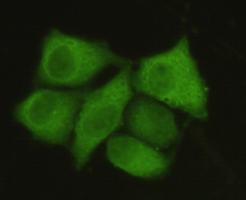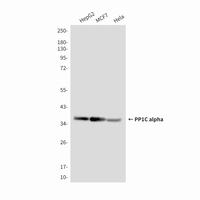| Cat.#: N261036 |
| Product Name: Anti-PP1C alpha (1H1) Mouse Monoclonal Antibody |
| Synonyms: Alpha isoform serine threonine protein phosphatase PP1alpha 1 catalytic subunit; Catalytic subunit; PP1A; PP1A_HUMAN; PP1alpha; PP2C ALPHA; PP2CA; Ppp1ca; Protein Phosphatase 2C Alpha Isoform; Serine threonine protein phosphatase PP1 alpha catalytic subunit; Serine threonine protein phosphatase PP1 alpha catalytic subunit protein phosphatase 1; Serine/threonine-protein phosphatase PP1-alpha catalytic subunit. |
| UNIPROT ID: P62136 |
| Background: Protein phosphatase that associates with over 200 regulatory proteins to form highly specific holoenzymes which dephosphorylate hundreds of biological targets. Protein phosphatase 1 (PP1) is essential for cell division, and participates in the regulation of glycogen metabolism, muscle contractility and protein synthesis. Involved in regulation of ionic conductances and long-term synaptic plasticity. May play an important role in dephosphorylating substrates such as the postsynaptic density-associated Ca2+/calmodulin dependent protein kinase II. Component of the PTW/PP1 phosphatase complex, which plays a role in the control of chromatin structure and cell cycle progression during the transition from mitosis into interphase. Regulates NEK2 function in terms of kinase activity and centrosome number and splitting, both in the presence and absence of radiation-induced DNA damage. Regulator of neural tube and optic fissure closure, and enteric neural crest cell (ENCCs) migration during development. In balance with CSNK1D and CSNK1E, determines the circadian period length, through the regulation of the speed and rhythmicity of PER1 and PER2 phosphorylation. May dephosphorylate CSNK1D and CSNK1E. Dephosphorylates the ‘Ser-418’ residue of FOXP3 in regulatory T-cells (Treg) from patients with rheumatoid arthritis, thereby inactivating FOXP3 and rendering Treg cells functionally defective (PubMed:23396208). Dephosphorylates CENPA (PubMed:25556658). Dephosphorylates the ‘Ser-139’ residue of ATG16L1 causing dissociation of ATG12-ATG5-ATG16L1 complex, thereby inhibiting autophagy (PubMed:26083323). |
| Immunogen: Purified recombinant human PPP1A protein fragments expressed in E.coli. |
| Applications: WB,ICC/IF |
| Recommended Dilutions: WB: 1/500-1/1000 IF: 1/50-1/200 |
| Host Species: Mouse |
| Clonality: Mouse Monoclonal |
| Clone ID: 1H1-F7-D8 |
| MW: Calculated MW: 38 kDa; Observed MW: 38 kDa |
| Isotype: IgG1 |
| Purification: Affinity Purified |
| Species Reactivity: Human |
| Conjugation: Unconjugated |
| Modification: Unmodified |
| Constituents: PBS (without Mg2+ and Ca2+), pH 7.3 containing 50% glycerol, 0.5% BSA and 0.02% sodium azide |
| Research Areas: Signal Transduction |
| Storage & Shipping: Store at -20°C. Avoid repeated freezing and thawing |

Immunocytochemistry analysis of PP1C alpha in HeLa cells using PP1C alpha antibody. | 
Western blot analysis of PPP1A in HepG2, MCF-7 and Hela lysates using PPP1A antibody. |
|












